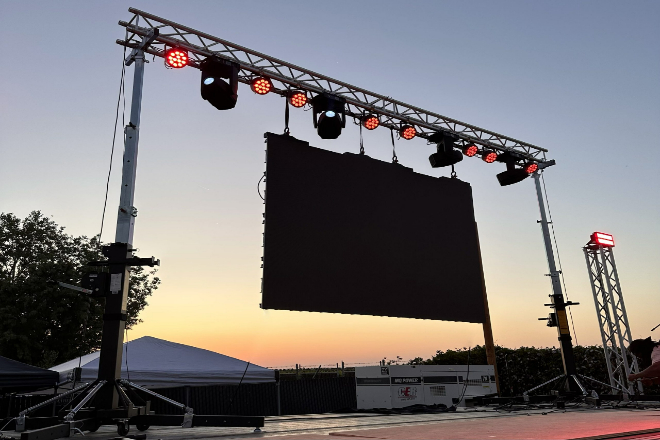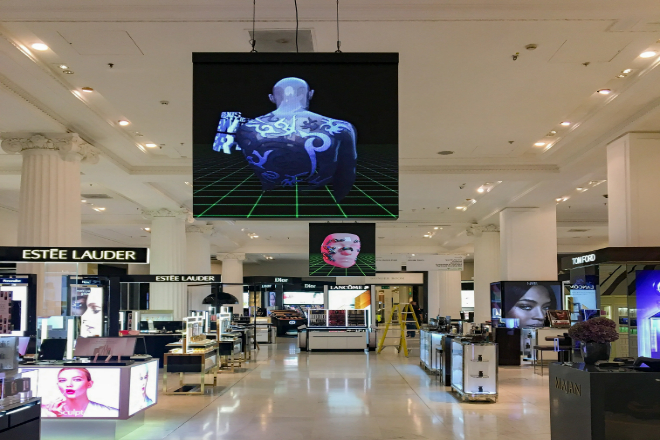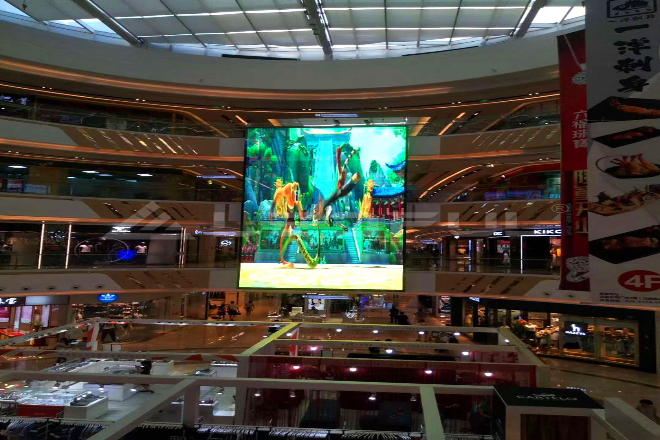مقدمة

Hoisting is a common installation method for شاشات عرض LED. From shopping malls to airports to stages, you can actually see hoisted LED display screens. So, can LED display screens be installed anywhere by hoisting?
In fact, not really. Each installation has certain prerequisites, and not everywhere can be installed. This article will help you to understand the hoisting method of LED display screens in detail.
1. Analysis of the basic concepts of LED display screen hoisting
When you walk into a high-end مركز تجاري, you look up and see a huge LED display screen shining on the ceiling, showing the latest fashion trends; or, at an outdoor concert, a huge screen is hung above the center of the stage, conveying the enthusiasm and passion of the scene in real time.
These are the charms of LED display screen hoisting. Simply put, LED display screen hoisting is to hang this magical “canvas” in a specific way, making it a beautiful landscape in the space.
There are many forms of hoisting, but they can be roughly divided into two categories: fixed hoisting and mobile hoisting. Fixed hoisting, as its name suggests, is basically immovable once installed. It is commonly seen in indoor shopping malls, museums, and other places.
Through professional hangers and fixings, the screen is firmly “nailed” in the air. Mobile hoisting is more flexible. It can adjust its position at any time as needed. For example, in some large-scale events or exhibitions, the screen can be moved to the best viewing angle by a crane or lifting platform to bring a different visual feast to the audience.
Why should the LED display be hoisted? There are actually many benefits behind this.
First of all, hoisting can greatly improve the utilization rate of space. In a city where every inch of land is valuable, every inch of land is particularly precious.
The hoisting method cleverly “sends” the screen to the sky, which not only does not occupy precious ground space but also makes the space look more open and transparent.
Secondly, hoisting can significantly enhance the visual effect. Imagine that when you stand in an empty exhibition hall and look up to see a huge screen slowly unfolding in the air. The shocking feeling is incomparable to the ground screen.
Moreover, through hoisting, we can adjust the screen to the best position according to the on-site environment and the audience’s perspective to ensure that everyone can enjoy the best visual experience.
Finally, hoisting can also meet the needs of diverse scenarios. Whether indoors or outdoors, whether commercial exhibitions or cultural performances, hoisting LED displays can easily cope with it. It can be flexibly adjusted according to the changes in the scene and become an indispensable visual element on various occasions.
2. General conditions that must be met for hoisting LED displays

If you want to hoist the LED display screen safely and coolly, you can’t just find a place to hang it. This is a prerequisite.
1). Structural support:
First, you have to find a solid “backing” for the LED display screen, which is the hoisting point. This is not something that can be done by just finding a corner or ceiling.
Make sure that the hoisting point has sufficient structural strength to steadily support the weight of the screen, and it must withstand the slightest disturbance, even the occasional “small vibration.”
Imagine if the hoisting point is a “tofu dregs project,” then wouldn’t the LED screen become a “flying screen in the air”? Therefore, you have to ask professionals to evaluate and ensure that the hoisting point is both strong and stable.
Moreover, load-bearing capacity is also the key. The LED screen plus various accessories is not light.
The hoisting point must be a “strong man” who can not only easily carry the screen but also have some spare power to deal with emergencies, such as a strong wind on a certain day or a few more decorations on the screen.
2). مزود الطاقة and signal:
Next, the LED screen must be connected to the “lifeline” – power and signal cables. The power supply must be stable, and it cannot be powered on and off at the same time. Otherwise, the LED screen will be like having “lightning disease.”
Therefore, you have to find a reliable power supply and make a backup. If the main power supply has a problem, the backup power supply can be immediately used.
The signal cable is like the “nerve” of the screen, and the signal transmission must be fast and accurate. The cables must be laid out reasonably, and don’t let them be tangled together like a mess. They must also be well protected so that they are not bitten by mice or damaged by wind and sun.
3). Safety regulations:
The last and most important point is to comply with safety regulations. This is not just a formality, but it is related to the safety of the LED screen and yourself. It must be in accordance with national standards and specifications; from design to construction, every step must be strictly controlled.
For example, fire prevention, LED screens, and hoisting structures must be made of flame-retardant materials and fire isolation belts must be set up. In case of accidental fire one day, the loss can be minimized.
Lightning protection is also the key, especially in areas with frequent lightning; lightning protection devices must be installed to protect the screen from the threat of “thunder rolling.”
There is also earthquake protection, which cannot be ignored. In places where earthquakes are frequent, the seismic resistance of the structure must be strengthened so that the screen can be as stable as Mount Tai when an earthquake comes.
In short, LED display hoisting is not a simple matter. You have to consider many factors, such as structural support, power supply, signal, safety regulations, etc., to ensure that the screen is safe and cool to “fly.” In this way, we can enjoy the visual feast brought by LED display screens on various occasions!
3. What are the key factors affecting the selection of hoisting locations?
Want to find a safe and good place to hoist your LED display? Don’t worry. Here are a few “golden rules” to help you get it done easily!
1). Environmental factors:
You have to look at the weather before choosing a place; after all, LED display screens are also “delicate.”
- درجة حرارة:
Think about it: on a hot day, you will sweat even if you wear thick clothes, and the same is true for LED display screens. If it is too hot, the parts inside it may “go on strike.” So, find a place with a suitable temperature and don’t let the screen “get heatstroke.”
- رطوبة:
When the humidity is high, electronic products are easily “damaged.” LED display screens are no exception. Too high humidity may cause it to short-circuit or even cause a fire. Therefore, when choosing a location, you have to avoid those “wet” places or add a “waterproof cover” to the screen.
- Wind:
When the wind is strong, the screen will shake; not only will you feel dizzy, but it may also fall and hit people. Therefore, in places with strong winds, you have to choose a more stable hoisting method to make the screen as stable as Mount Tai.
Also, don’t forget the “troublemaker” of natural light. When the sun is directly shining, the screen may reflect light, making it difficult for the audience to see clearly. At this time, you can add a sunshade to the screen or adjust its brightness and contrast to make the display effect even better.
2). Site characteristics:
After choosing the weather, the next step is to look at the site.
- Space size and shape:
You have to measure the size of the site first and then look at the size of the screen. Don’t find out that the site is too small and the screen can’t be unfolded after the screen is installed. In addition, the shape of the site must also be considered so that the screen is not deformed by “squeezing.”
- Ground/wall conditions:
What material is the ground or wall made of? Can it bear the weight of the screen? These issues must be considered clearly. If it is a weak material, it must be reinforced to prevent the screen from falling, which is very dangerous.
3). Laws, regulations, and permits:
Finally, don’t forget the laws and regulations that need to be paid attention to the most.
- Urban planning and aesthetic requirements:
You have to look at the city’s planning map to ensure that the installation of the screen will not damage the city landscape.
Also, don’t forget to consider the problem of light pollution so that the screen will not become the “brightest star in the night sky,” which is not good for disturbing the public.
- Approval from property management and government departments:
Before installing the screen, you must first “say hello” to the property management and government departments to obtain the necessary permits. Don’t forget to communicate with the surrounding residents and merchants to ensure that they will not be angry with your LED screen.
4. Hoisting challenges and solutions in special scenarios

Hoisting LED screens in special scenarios does face a series of unique challenges. The following is a detailed analysis of the challenges and solutions for high-altitude hoisting, waterside or humid environments, and hoisting on complex structural surfaces:
1). High-altitude hoisting:
1.1). Challenges:
High safety risks: High-altitude operations themselves have greater safety risks, such as falling personnel and hitting objects.
الصيانة الصعبة: Once the LED screen hoisted at high altitude fails, it will be very difficult to repair. Not only does it require professional personnel and equipment, but it may also affect normal operations.
1.2) الحل:
- Strict safety measures:
Before high-altitude hoisting, the hoisting equipment, ropes, safety belts, etc., must be strictly inspected to ensure safety and reliability.
At the same time, operators must receive professional training and strictly abide by safety operating procedures.
During the operation, a safety cordon should be set up to prohibit unauthorized personnel from entering the operation area.
- Design for easy maintenance:
When designing the hoisting scheme, the convenience of later maintenance should be fully considered.
For example, a detachable hoisting structure can be designed to facilitate reinstallation after repair on the ground, or a maintenance channel can be reserved so that maintenance personnel can easily approach the LED display for inspection.
2). Waterside or humid environment:
2.1). Challenges:
Moisture erosion: Moisture in a waterside or humid environment can easily erode the electronic components inside the LED display, causing short circuits, damage, and other problems.
Humidity influence: A high-humidity environment may cause condensation on the surface of the display, affecting the display effect and service life.
2.2) الحل:
- Choose waterproof and moisture-proof materials:
When purchasing LED display screens, materials with waterproof and moisture-proof functions should be selected, such as display screens with an IP65 rating or above.
These display screens usually have sealed shells and special waterproof materials, which can effectively resist moisture erosion.
- Strengthen sealing treatment:
During the installation process, the joints, interfaces, and other parts of the LED display screen should be strictly sealed to prevent moisture penetration. Sealant, waterproof gasket, and other materials can be used for sealing.
- Regular maintenance inspection:
Regular maintenance inspection of the display screen is carried out to promptly detect and deal with potential moisture erosion problems.
After humid seasons or bad weather, the inspection frequency should be increased to ensure that the display screen is in good condition.
3). Complex structure surfaces (such as curved walls):
3.1) التحديات:
Difficult installation: Complex structure surfaces (such as curved walls) are difficult to install and require precise measurement and customized installation solutions.
Limited display effect: If improperly installed, it may affect the display effect and audience experience of the LED display screen.
3.2) الحل:
- Accurate measurement and design:
Before installation, the curved wall should be accurately measured, and a customized installation solution should be designed based on the measurement results.
This includes determining the size, shape, installation angle, and other parameters of the display screen to ensure that it fits the curved wall tightly and presents the best display effect.
- Use professional tools and materials:
During the installation process, professional tools and materials such as curved adapters, flexible connectors, etc., should be used to adapt to the special structure of the curved wall.
These tools and materials can provide greater installation flexibility and stability.
- On-site debugging and optimization:
After installation, on-site debugging and optimization should be carried out to ensure that the display effect and audience experience of the display screen are in the best state.
This includes adjusting the brightness, contrast, color, and other parameters of the display screen, as well as optimizing the installation angle and position.
خاتمة
In summary, the installation of LED display screens is not a one-time or random process. It requires us to comprehensively consider factors such as the environment, site, laws and regulations, and technology to ensure safety, compliance, and effect.
وأخيرًا، إذا كنت تريد معرفة المزيد عن شاشات العرض LED، يرجى الحصول على اتصال معنا.
